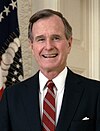Pollution Prevention Act of 1990
 | |
| Acronyms (colloquial) | PPA |
|---|---|
| Enacted by | the 101st United States Congress |
| Citations | |
| Public law | 101-508 |
| Statutes at Large | 104 Stat. 1388-321 |
| Codification | |
| Titles amended | 42 |
| U.S.C. sections created | 13101-13109 |
| Legislative history | |
| |
The Pollution Prevention Act of 1990 (PPA) is a United States federal law that created a national policy to promote the prevention of pollution or reduction at pollution sources wherever possible. The law also expanded the Toxics Release Inventory (TRI), a waste reporting program administered by the United States Environmental Protection Agency (EPA).
Overview
The Pollution Prevention Act focused industry, government, and public attention on reducing the amount of pollution through cost-effective changes in production, operation, and raw materials use. Opportunities for source reduction are often not realized because many existing environmental regulations focus on waste treatment and disposal. Consequently, industrial resources have been focused on compliance with the treatment and disposal requirements.
Implementation
EPA efforts to promote prevention practices include waste permitting procedures, revisions to regulations, technical assistance to industry and government agencies, and enforcement. The agency also makes efforts to link pollution prevention to public information about chemicals, such as in the TRI program.
See also
References
- ^ United States. Pollution Prevention Act of 1990. Pub. L. 101–508, title VI, §6602. Approved November 5, 1990.
- ^ "Summary of the Pollution Prevention Act". Washington, D.C.: U.S. Environmental Protection Agency (EPA). 2021-09-28.
- ^ Auer, Charles M.; Kover, Frank D.; Aidala, James V.; Blunck, Chris; Greenwood, Mark A. (April 2020). "Toxic Substances: A Half Century of Progress" (PDF). Grasonville, MD: EPA Alumni Association.
Further reading
- Burnett, Miles L. (1998). "The Pollution Prevention Act of 1990: A Policy Whose Time Has Come or Symbolic Legislation?" (PDF). Environmental Management. 22 (2): 213–224. doi:10.1007/s002679900098. ISSN 0364-152X. PMID 9465131. S2CID 10487299.
External links
- As codified in 42 U.S.C. chapter 133 of the United States Code from the LII
- As codified in 42 U.S.C. chapter 133 of the United States Code from the US House of Representatives
- Title VI subtitle F of Omnibus Budget Reconciliation Act of 1990 (PDF/details) as amended in the GPO Statute Compilations collection
- Omnibus Budget Reconciliation Act of 1990 as enacted in the US Statutes at Large

